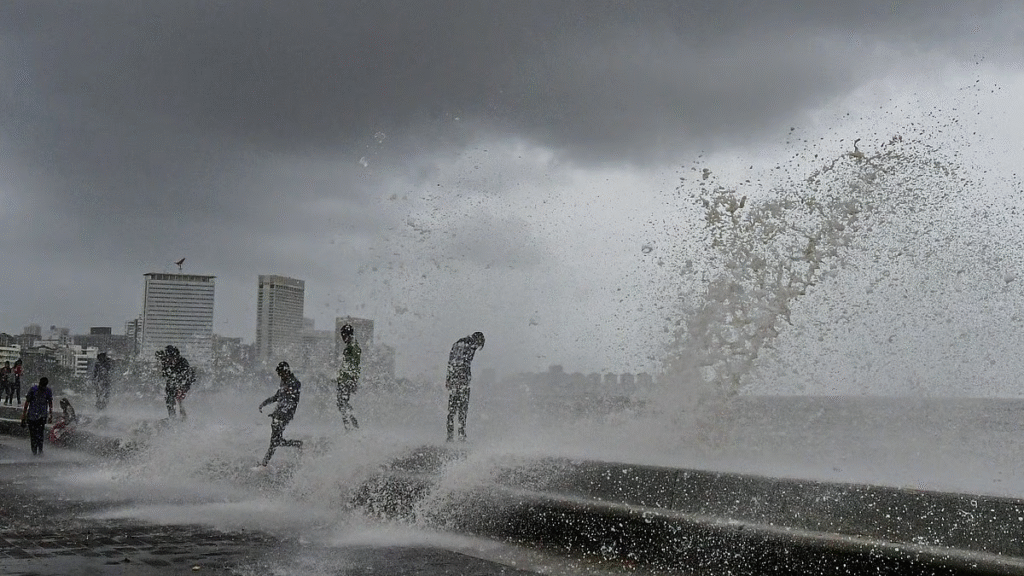Colaba in Mumbai records 90mm more rain than average, triggering high tide alert with sea levels expected to reach 4.87 meters. Stay updated on flooding risks, traffic disruptions, and IMD warnings
The India Meteorological Department (IMD) announced that as of Thursday, the Colaba observatory measured 548.2 mm of rainfall, surpassing the average of 542 mm by 90 mm. In contrast, the suburban Santacruz station recorded merely 478 mm, which is 10% below its average of 537 mm for May.
Authorities have alerts to stop visitors from accessing the beach at Juhu when the tide is high. Juhu beach has captured interest as Mumbai’s island city section received more than its typical June rainfall.
The IMD has announced a yellow alert for heavy rainfall anticipated until the end of June. Since the monsoon started on May 26, the earliest in 75 years, Colaba has witnessed heavy rains, while suburban regions have received less rainfall.
The extraordinary excess rainfall comes after unprecedented figures in May, with Colaba surpassing average rainfall by more than 3,025%. The beneficial weather patterns leading to heightened rainfall have been positioned in a way that the southern regions of Mumbai experience greater precipitation.
Locations such as Nariman Point and Byculla experienced more than 200 mm within just one day. The IMD predicts ongoing intense rainfall in specific areas of Mumbai and nearby districts such as Thane and Palghar, with an orange alert announced for Raigad and Ratnagiri this weekend.

Mumbai, India’s financial capital, is once again witnessing the full force of the monsoon.
On Thursday, the India Meteorological Department (IMD) reported that Colaba, one of the city’s key weather observatories, had surpassed its average rainfall by 90mm — a stark indication of the intensity of this season’s downpour. To add to the concern, the IMD has issued a high tide alert with sea levels expected to touch 4.87 meters, potentially putting large parts of the city at risk of waterlogging and flash floods.According to the IMD data, Colaba typically records about 360mm of rainfall by the end of June. However, this year, the region has already received over 450mm, with the last 24 hours contributing significantly due to continuous and heavy downpour. This surplus of 90mm has raised alarms, especially given Mumbai’s notorious history with monsoon-related disruptions.
Colaba is often used as a representative marker for rainfall in southern Mumbai, and excess rainfall here typically indicates more widespread impact across the island city.
The Municipal Corporation of Greater Mumbai (MCGM) has confirmed that the Arabian Sea is expected to rise up to 4.87 meters, the highest so far this season. This high tide, coinciding with continuous rainfall, increases the risk of severe waterlogging in low-lying areas such as Dadar, Sion, Kurla, Parel, and Mahim.

When high tides occur, drainage systems become less effective in channeling rainwater into the sea. If heavy rainfall aligns with these tidal peaks, Mumbai’s stormwater systems are quickly overwhelmed, leading to flood-like situations within a matter of hours.
The IMD has placed Mumbai under an “Orange Alert”, signifying that heavy to very heavy rainfall is likely in isolated areas. Surrounding districts such as Thane, Palghar, and Raigad are also under similar warnings. The alert covers the next 48 hours, during which rainfall may exceed 115.6mm to 204.4mm in some parts of the city.
Key IMD Classifications:
- Yellow Alert: Be aware
- Orange Alert: Be prepared
- Red Alert: Take action (not yet issued for Mumbai, but may follow if conditions worsen)
Civic authorities have activated flood preparedness measures in 27 chronic flood spots across Mumbai. These include:
- Hindmata (Parel)
- Milan Subway (Santacruz)
- Gandhi Market (Sion)
- Chembur Station Road
- Andheri Subway
- King’s Circle
Each of these zones is equipped with dewatering pumps, mobile flood response units, and emergency evacuation teams ready to respond at short notice.
As rainfall intensifies and high tide approaches, several traffic advisories have been issued:
- Western Express Highway: Slow-moving traffic reported between Andheri and Goregaon
- Eastern Express Highway: Congestion between Ghatkopar and Sion
- Suburban Rail: Minor delays reported on Central and Western lines
- BEST buses have also rerouted 12 key routes to avoid waterlogged areas
The Mumbai Traffic Police have urged citizens to avoid venturing out unless absolutely necessary and advised the use of Google Maps, MapMyIndia, and other real-time navigation apps to check road closures.
The Brihanmumbai Municipal Corporation (BMC) has assured the public that emergency response mechanisms are fully activated.
- Over 230 water pumps have been deployed
- Disaster Control Room is monitoring live updates from rain gauges installed across 100+ points in Mumbai
- NDRF teams are stationed at Chembur and Andheri for rapid response
Additionally, school authorities have been requested to remain on standby for potential closures in case of continued downpours. So far, no closure orders have been issued.
Stagnant water due to heavy rainfall poses significant health risks, including waterborne diseases such as leptospirosis, cholera, and dengue. The BMC’s health department is:
- Disinfecting waterlogged areas with bleaching powder
- Distributing chlorine tablets
- Launching awareness campaigns in flood-prone communities
Residents are advised to boil drinking water, avoid direct contact with flood water, and seek medical help at the first signs of fever or rashes.
According to the IMD’s 5-day forecast:
- June 28: Heavy rain, maximum temperature 29°C, minimum 24°C
- June 29: High possibility of thunderstorms
- June 30: Moderate rain with strong sea winds
- July 1-2: Heavy rain likely to continue with isolated very heavy spells
Winds are expected to remain strong, reaching speeds of 40–50 km/h, especially along the coast
To stay safe during the ongoing weather events, here are some precautionary measures:
✅ Avoid traveling during high tide timings (consult IMD/BMC alerts)
✅ Carry waterproof clothing, extra power bank, and essential medicines
✅ Avoid parking vehicles in low-lying areas
✅ Do not attempt to wade through waterlogged roads
✅ Stay tuned to official handles of BMC, IMD, and Mumbai Police for accurate updates















 Categories
Categories









